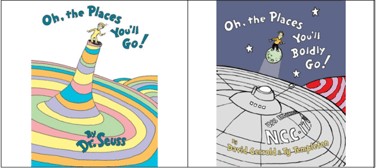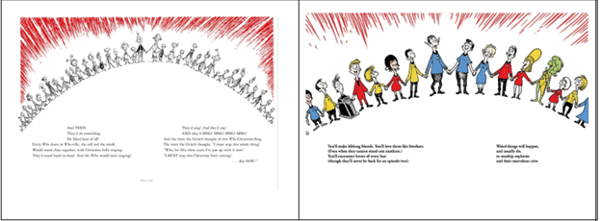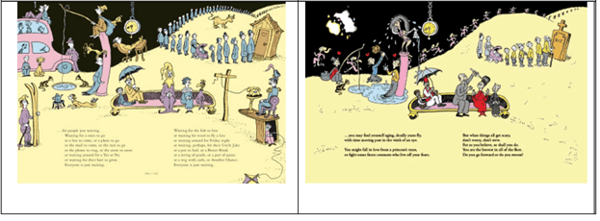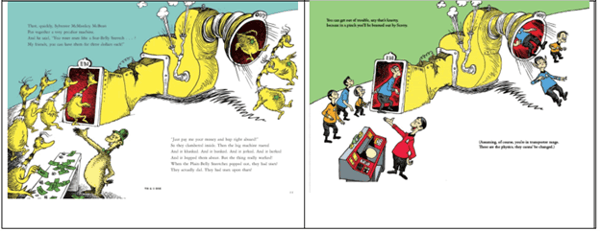- January 6, 2021
- Melissa L. Watt
- Intellectual Property
 The Ninth Circuit recently examined a mashup that infuses themes and characters from the popular television series Star Trek into Dr. Seuss works, namely "Oh, the Places You'll Go!" The defendants advocated for a novel interpretation of the fair-use doctrine – asserting that fair use is not an affirmative defense, and if it is, a finding that the work is transformative shifts the burden to the plaintiff to demonstrate the fourth fair-use factor: potential market harm. The Circuit court determined that the mashup is not fair use permissible under copyright laws, finding that the district court improperly shifted to the plaintiff the burden of demonstrating that the affirmative defense of fair use did not apply. The opinion, reversing summary judgment in part, opens with a lyric of its own:
The Ninth Circuit recently examined a mashup that infuses themes and characters from the popular television series Star Trek into Dr. Seuss works, namely "Oh, the Places You'll Go!" The defendants advocated for a novel interpretation of the fair-use doctrine – asserting that fair use is not an affirmative defense, and if it is, a finding that the work is transformative shifts the burden to the plaintiff to demonstrate the fourth fair-use factor: potential market harm. The Circuit court determined that the mashup is not fair use permissible under copyright laws, finding that the district court improperly shifted to the plaintiff the burden of demonstrating that the affirmative defense of fair use did not apply. The opinion, reversing summary judgment in part, opens with a lyric of its own:
"In Dr. Seuss’s classic book, Oh, the Places You’ll Go!
(Go!), the narrator counsels the protagonist on a path of
exploration and discovery. The book closes with this note
of caution:I’m sorry to say so
But, sadly it’s true
That Bang-ups
And Hang-ups
Can happen to you.If he were alive today, Dr. Seuss might have gone on to say
that 'mash-ups can happen to you.'"
In November 2016, Dr. Seuss Enterprises, L.P. ("Seuss") brought an action for copyright infringement, trademark infringement, and unfair competition against ComicMix LLC and several individuals involved in authoring, illustrating, and editing the work (collectively "ComicMix"). The suit alleged that ComicMix had exploited Dr. Seuss's works in the creation of its book "Oh, the Places You'll Boldy Go!" ("Boldly") which is a Star Trek mashup incorporating elements of several Dr. Seuss works.
Two of the primary issues before the court were (1) whether the fair use doctrine is an affirmative defense, and (2) whether Boldly is a fair use of Go!. The district court granted Defendants' summary judgment motion, finding that Defendants' use of Dr. Seuss's works was not copyright infringement because it is fair use.
"Fair use analysis, like the Go! protagonist's life journey, is 'a Great Balancing Act.'" Fair use is codified in 17 U.S.C. § 107. To determine whether a party has established fair use, a court must consider four non-exclusive factors:
(1) the purpose and character of the [defendant’s] use, including
whether such use is of a commercial nature or is for nonprofit
educational purposes;
(2) the nature of the copyrighted work;
(3) the amount and substantiality of the portion used in relation to
the copyrighted work as a whole; and
(4) the effect of the use upon the potential market for or value of
the copyrighted work.
Id. However, codification of these factors was not intended to interfere with common-law application of fair use. Campbell v. Acuff-Rose Music, Inc., 510 U.S. 569, 577 (1994) (citing H.R. Rep. No. 94-1476, p. 66 (1976)). Instead of a bright-line rule or application of categories of presumptive fair use, courts must engage in case-by-case analysis to determine whether the fair-use doctrine applies. The Ninth Circuit found that all the statutory factors weigh heavily in favor of Seuss and concluded that Boldly did not make fair use of Go!
Boldly Evolves from a Trekkie Kickstarter Campaign to a Dr. Seuss Lawsuit
Boldly was the brainchild of Defendants David Gerrold and Glenn Hauman, both Star Trek enthusiasts. Gerrold was once employed by Paramount Television to write episodes of the television show Star Trek. Hauman is the owner of Defendant ComicMix and a devoted "Trekkie." Together, Gerrold and Hauman hatched the idea for what would become Boldly. On August 31, 2016, Defendants launched a Kickerstarter campaign to raise funds to produce Boldy. Seuss sent several cease and desist letters to Defendants after becoming aware of the project via the Kickstarter campaign. ComicMix continued to pursue the publication and sale of Boldly and never sought a license for the work from Seuss.
Seuss alleges that the work "misappropriated many of the most recognizable protected elements of the Dr. Seuss Copyrighted Works" including the title, story arc, characters, and illustrations of Go!, and "key protected elements of Horton Hears a Who, How the Grinch Stole Christmas!, The Lorax, and The Sneetches and Other Stories." There is no dispute that the book is based on Dr. Seuss's books; many of the pages are nearly identical to the Dr. Seuss works, many of which were included in the Ninth Circuit's opinion and are republished here for the purpose of illustrating the issues before the court:



Indeed, the illustrator, Ty Templeton, admitted to spending "'about seven hours' to copy a single illustration because he 'painstakingly attempted to make' the illustrations in Boldly 'nearly identical' to its Seussian counterpart."
The Ninth Circuit Finds the Fair Use Factors Weigh in Favor of Seuss and Fair Use is (Still) an Affirmative Defense
In considering the first three factors, the Ninth Circuit found each factor weighed against the district court's finding that Boldly is fair use. The Circuit court was not persuaded by ComicMix's argument that Boldy is parody because it uses adult themes while invoking the Seussian elements to make a humorous book. Instead, it found that Boldly merely copies elements from Seuss books, and does not ridicule or criticize. Nor did the Circuit court find the benchmarks of transformative works, determining that Boldly merely repackaged Go! and paralleled Go!'s purpose. While acknowledging the limited relevance of the second factor, the court found that Boldly's copying of the creative and expressive elements of Dr. Seuss's works "tilts the second factor against fair use." As to the third factor, the Ninth Circuit found ComicMix's use of Seuss works to be substantial. Notably, Bodly copied nearly 60% of Go! – 14 of Go!'s pages – in addition to significant illustrations from two other Dr. Seuss works, How the Grinch Stole Christmas and The Sneetches. ComicMix offered no justification for its extensive copying of Seuss works.
Finally, the fourth factor considers the potential market value and market harm posed by the work at issue. On appeal, Seuss argued that the district court improperly placed the burden to establish market harm on Seuss. In response, ComicMix asserted that fair use is not an affirmative defense, and that once ComicMix had established that the work is transformative, the burden shifted to Seuss to prove potential market harm.
At oral argument, the appellate panel pressed ComicMix for support of its position that once a work is determined to be transformative, the burden on the fourth factor shifts from the proponent of the work to the opponent – here from ComicMix to Seuss. In response, ComicMix admitted that no caselaw explicitly supports that position and pointed to the portion of Campbell stating that it would be difficult for a defendant to establish fair use without evidence on the fourth factor. ComicMix then claimed other transformative works that use Seuss themes and character have been on the market with no evidence of market harm and directed the court to Lenz v. Universal Music Corp., 815 F.3d 1145 (9th Cir. 2016). ComicMix argued that, in Lenz, the Ninth Circuit had deviated from its controlling precent setting forth that fair use is an affirmative defense. The panel, however, quickly pointed out that Lenz applies to a narrow swath of copyright cases that involve the safe harbor provision of the Digital Millennium Copyright Act for internet service providers; and further explained in its opinion that, even in Lenz the court reiterated its position that fair use is an affirmative defense that places the burden on the proponent of the fair use doctrine.
Following the United States Supreme Court decision in Campbell, the Ninth Circuit found that fair use is an affirmative defense, which unambiguously places the burden on the proponent. It also agreed with Seuss on the fourth factor and determined the "non-transformative and commercial use of Dr. Seuss's works likely leads to 'cognizable market harm to the original.'" Ultimately, the court held that "ComicMix created, without seeking permission or a license, a non-transformative commercial work that targets and usurps Go!'s potential market." Upon weighing the four statutory factors, the court held that ComicMix failed to meet its burden and cannot maintain a fair use defense to Seuss's copyright claim.
Seuss Does Not Have a Valid Claim for Trademark Infringement
It was not all bad news for ComicMix though. The Ninth Circuit affirmed the district court in part, holding that Seuss's claim for trademark infringement was properly dismissed based on a finding that the Lanham Act did not apply. Under the Rogers test, the court explained that the trademarks used in the title, typeface, and style were relevant to executing the artistic purpose of the mashup and found that the trademark use was not explicitly misleading.
Accordingly, the Ninth Circuit affirmed the district court's Fed.R.Civ.P. 12(c) dismissal and summary judgment decision for ComicMix on Seuss's trademark infringement claim but reversed and remanded the district court's summary judgment decision on Seuss's copyright claim.
Thus, the Ninth Circuit subjected the Boldly mashup to the same kind of bang-ups and hang-ups warned of in Go!: fair use is an affirmative defense and a finding that the work is transformative does not shift the burden to the plaintiff to demonstrate potential market harm. Creators should take heed when attempting mashups and other similar works to consider how much ammunition will be available to them in establishing each of the fair use factors before introducing a new work into the market.
